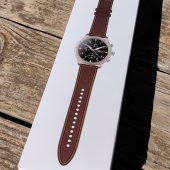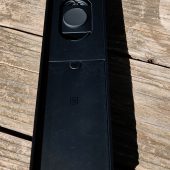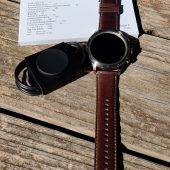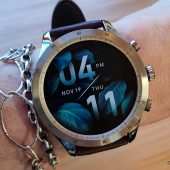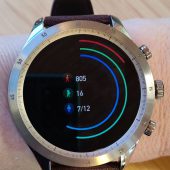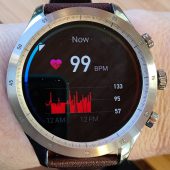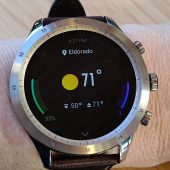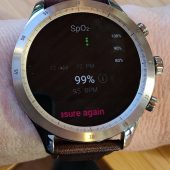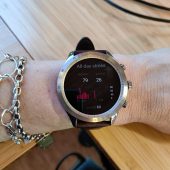The Lowdown
Made from a single block of polished titanium alloy with more of a traditional men’s watch design, the Zepp Z has a classic style that is loaded with smart features and intelligence-assisted fitness tracking.
Overall
Pros
- Beautiful and bright display
- Comfortable to wear throughout the day and while sleeping
- Waterproof to 50 meters
- Battery life is up to 15 days long if you aren’t using notifications for all the apps that usually send them to you from your phone
- In-depth sleep, heart rate, and step monitoring
- Tells you to get up and move when you’ve been idle too long
- Built-in GPS and GLONASS
Cons
- As with the Zepp E, there is a lot of possible information that can’t populate on the Zepp app because Google Fit is the gatekeeper, and they aren’t allowing data to flow back and forth between apps — it is what it is
- Don’t expect to be able to respond to calls or text messages from the watch — you’ll get notifications only
- App notifications can significantly cut down on battery life
- Still waiting on that Amazon Alexa update
- It’s expensive for a non-Wear OS watch
- The upper button doesn’t appear to have functionality
I recently reviewed the Zepp E Circle, one of the most gorgeous and functional health-centric watches available. Zepp has already added another watch to their line — the Zepp Z. Made from a single block of polished titanium alloy with more of a traditional men’s watch design, the Zepp Z has a classic style that is loaded with smart features and intelligence-assisted fitness tracking.

Like most other health-centric fitness tracking watches, the Zepp Z offers detailed step counting, sleep and nap monitoring, and it’s programmed with twelve sports modes so you can track workout activities. Zepp Z has 50-meter water resistance; you can wear it while swimming or showering — though you might want to swap out the lovely thick leather band if you choose to wear it during those activities; it’s easy enough to do as the watch has pins built into its 22mm strap ends. The Zepp Z also has built-in heart and Sp02 monitors, and like the Zepp E, it will remind you to stand up periodically when you aren’t active enough.
With the information that the Zepp Z gathers about your heart rate and daily activities, it produces a single metric, which they call PAI (Personal Activity Intelligence). PAI helps you better understand your physical condition’s status based on your heart rate and physical activity; your goal is to hit 100 PAI each day. Zepp says that because their watch offers “all-day monitoring and elevated heart-rate warnings, heart-rate monitoring is simpler and more accurate. Stress is also an underlying cause of many health problems.
Using self-developed algorithms, the Zepp Z monitors your stress levels and helps you understand when you need to relax.” Like the Zepp E, the Zepp Z is also a smarter-watch — the term I use when we’re not talking about a full-blown Wear OS or Apple Watch. You can use the Zepp Z to set timers, set alarms, check the weather forecast, and receive notifications of calls and text messages as they arrive on your smartphone, though it will impact battery life.
With similar packaging to the Zepp E, the Zepp Z’s box is sleek and minimal. Inside, you’ll find the watch, a USB Type-A charging cable with an attached round magnetic charging base, and a product manual.
Unlike the Zepp E’s more unisex style, the Zepp Z goes for a more traditionally masculine style. The watch’s hardware is top-notch with a classic crown with two push buttons style and engraved second markers around the dial. The round, lugged case from side to side measures 48mm across, and it is 13mm thick in total due to the slightly protruding heart rate monitor on its back.
The Zepp Z is available in a single style — titanium case with a brown leather strap with contrasting white stitching. The overall impression it gives is strong, finished, and yes — expensive. Amazingly enough, though the watch looks hefty, it only weighs a total of 1.7 ounces (50 grams). You’re not going to forget that you are wearing it, but it doesn’t feel like a wrist dead-weight. Oddly enough, I found it quite comfortable to sleep with on, which was a good thing for sleep tracking.

As I mentioned above, the Zepp Z’s body is made from a single piece of polished titanium alloy. The watch’s tempered glass display has been treated with an NTC nanotech coating to be resistant to scratches and fingerprints. The 1.39″ AMOLED touchscreen display has 454 x 454 pixels at 326 ppi, and it has a peak brightness of 550 nits.
Where the Zepp E had a single button on the right side of the case, the Zepp Z has a multifunctional, ridged, and rotatable crown. After pairing the watch with the Zepp app that is available in the Google Play or Apple App stores and setting up your account (if you don’t already have one), you can start to explore the crown and buttons’ uses.
Pressing the crown will turn on the watch’s display if it hasn’t already been activated. When the watch’s display is already on, pressing it will bring up a menu of built-in apps, widgets, and settings. At first, the button above the crown doesn’t seem to have a function — it doesn’t turn or seem to press in any. This button is listed as a “front electrode” in the included user manual, but there is no instruction on its use.
When you dig into the settings, though, there is a selection called Health Key. Entering that setting shows that when in the dial interface, pressing that button will “quickly enter the health application, which negatively impacts battery life.” And that “in humid environments, the watch may register accidental touches.” Under that notice, there is a list of options you can activate with that button, including Heart Rate, Sp02, Stress, and Turn Off, which I soon realized was the default. So I set it to Heart Rate, expecting that pressing that button would activate that function when I pressed it, but alas … it doesn’t seem like it does anything.
The lower button comes set from the factory to pull up the activity tracking app, which makes it easy to scroll through the 12 included workout trackers. You can also go into User Preferences under Settings and then selecting ‘Press the Lower Button.’ You can then select the feature you would like to open when pressed; in my case, I need timers quite often, so I chose the count-down timer.

There are over 50 watch faces to choose from; this is the default face, which is quite featured.
So let’s take a quick walk around the watch …

Here’s a view of the Zepp Z from the right side, with the crown and buttons we have already discussed.

As with most watches, there are no buttons on the left side.
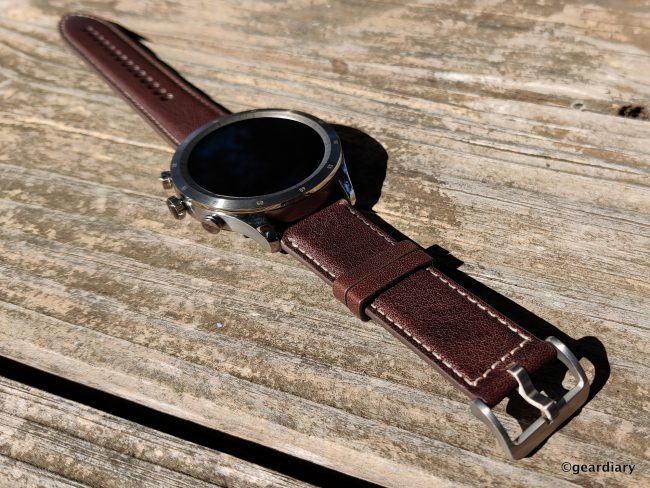
A view from the top.
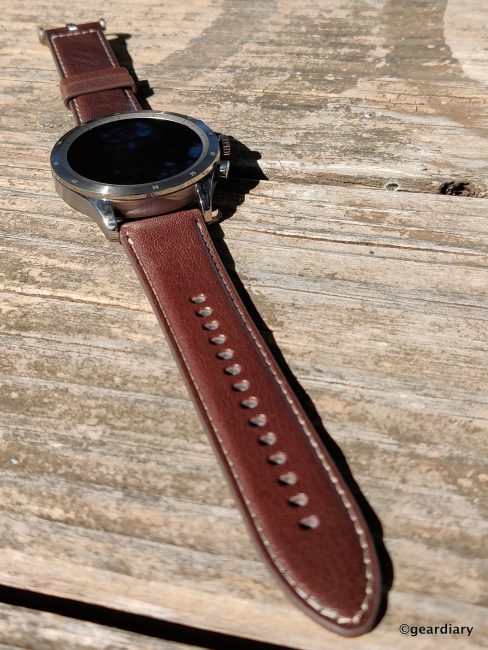
And a view from the bottom.
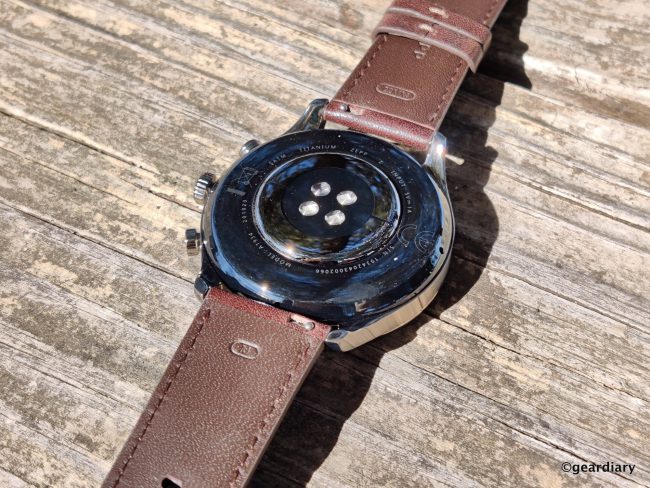
On the back of the Zepp Z, there is a microphone, a rear electrode, and the optical heart rate & blood oxygen sensor.
As far as the Zepp app and the Zepp Z functions, I’ll refer you to my Zepp E review, where I did a deep dive into the app, its functions, and features. There are quite a few integration limitations if you come from a health app and device ecosystem like Withings, for instance. But from solely the Zepp Z’s perspective, some new functionality is added by the scrolling crown and the bottom button, which can be programmed to quickly pull up an often-used feature. Swiping left on the watch’s face will reveal the following, depending upon how you set up the features you want to see in the Zepp app.
- Starting on the main watch face and then swiping left reveals …
- Your PAI score for the day so far.
- Your tracked movement.
- Your heart rate.
- The weather.
Under the main menu on the watch, you’ll also find these …
- Your SpO2 reading.
- A measurement of your stress levels throughout the day.
With the Zepp app, you can keep track of your SpO2 level readings over time as well as your stress levels. As Zepp explains, “using self-developed algorithms, the Zepp Z monitors your stress levels. No matter what kind of day you’ve had, the watch helps you understand when you need to relax.”
The Zepp Z uses both GPS and GLONASS positioning systems to deliver precise location information; this allows you to track and review your route after completing a run, cycling, hiking, or other outdoor activities.
Perhaps the best thing about the Zepp Z, on top of its good looks, is that the battery can last up to two weeks. Depending on the settings you’ve chosen and how many notifications you receive throughout the day (you can read them, but you can’t reply to them from the watch), the battery can last up to two weeks. My use seems on track to get about 9 solid days, which is pretty solid. If you have the Zepp Z set for basic use without any health tracking (but why would you do that?), you can get up to 30 days of battery life. The included magnetic wireless charger is easy to use, as it can snap onto the watch from several positions without having to line up pins, as we had to on the Zepp E.
Zepp says that the Zepp Z can act on voice commands to interact with Alexa on your mobile phone to control smart home appliances and to do all the other things that you use the Alexa assistant for, including controlling your smart home appliances, setting alarms, and timers, checking the weather, etc. The Over the Air (OTA) update for that capability hasn’t come yet, so I couldn’t test it. I do not doubt that it will be coming soon, though, as Zepp has been excellent about doing regular updates and adding features to the Zepp E and the Zepp app.
The Zepp Z can be personalized with a watch face that matches your aesthetic; there are over 50 to choose from, but I was glad to see that the Tropical Rainforest face that I enjoyed on the Zepp E was also available on the Zepp Z. It helps soften the manliness of this larger watch just a bit, don’t you think?
Is the Zepp Z for you? Well, there are obviously some trade-offs if you are hoping for more of a Wear OS experience. You can’t add apps, and though you’ll get notifications of them as they come in, you can’t answer calls or texts directly from the watch. You will get amazing battery life compared to a Wear OS or Apple Watch; I think that the extra battery life is worth the trade-off, but that’s something only you can decide.
If you want a premium smarter watch that doesn’t look like an ugly chunk of plastic and has a traditional style, the Zepp Z is a great choice. But if you are looking for something a little bit sleeker and easily $100 less, I would direct you to the Zepp E Circle or its brother, the Zepp E Square. At $349, you could also pick up a Wear OS watch if you’re an Android user or an Apple Watch SE if you’re an iOS user.
With the Zepp Z, you’re paying a premium for the titanium body and traditional styling. The functionality tradeoffs might not seem that big of a deal at $249, but at $349, they can seem a bit more glaring.
The Zepp Z sells for $349, and it is available directly from the manufacturer and other retailers, including Amazon.
Source: Manufacturer supplied review sample
What I Like: Beautiful and bright display; Comfortable to wear throughout the day and while sleeping; Waterproof to 50 meters; Battery life is up to 15 days long if you aren’t using notifications for all the apps that usually send them to you from your phone; In-depth sleep, heart rate, and step monitoring; Tells you to get up and move when you’ve been idle too long; Built-in GPS and GLONASS
What Needs Improvement: As with the Zepp E, there is a lot of possible information that can’t populate on the Zepp app because Google Fit is the gatekeeper, and they aren’t allowing data to flow back and forth between apps — it is what it is (Please refer to my Zepp E review for a more in-depth dive into the app’s features); Don’t expect to be able to respond to calls or text messages from the watch — you’ll get notifications only; App notifications can significantly cut down on battery life; Still waiting on that Amazon Alexa update; It’s expensive for a non-Wear OS watch; The upper button doesn’t appear to have functionality

